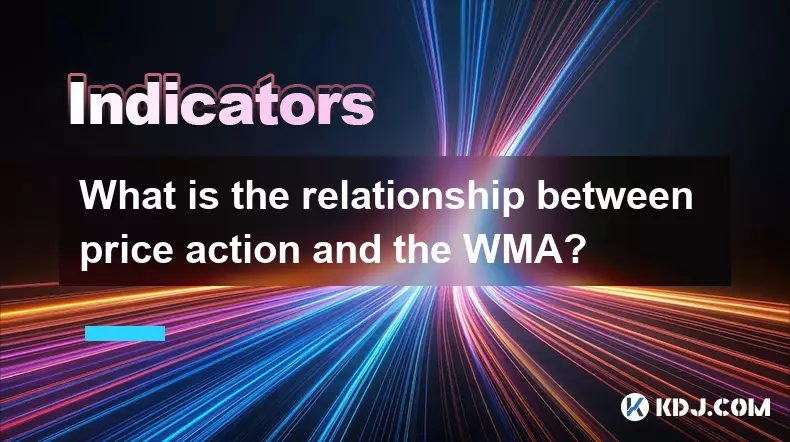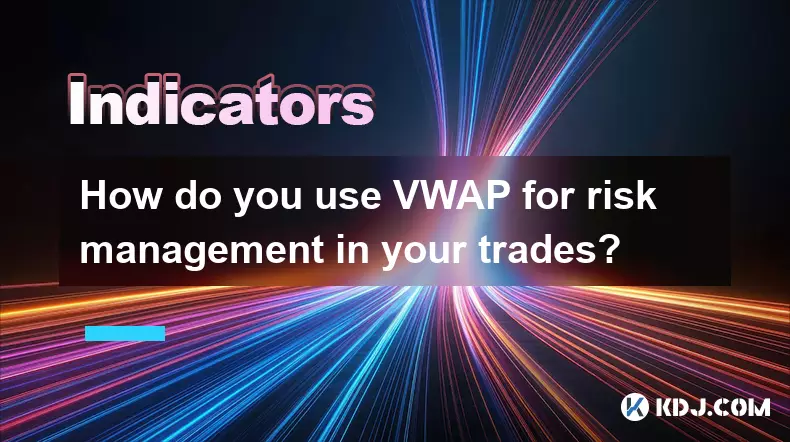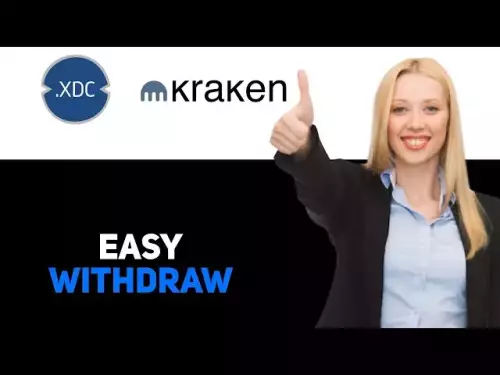-
 bitcoin
bitcoin $114684.631706 USD
-0.87% -
 ethereum
ethereum $4228.677447 USD
1.58% -
 bnb
bnb $1294.880693 USD
-1.16% -
 tether
tether $1.000819 USD
-0.02% -
 xrp
xrp $2.605138 USD
2.79% -
 solana
solana $209.908690 USD
5.89% -
 usd-coin
usd-coin $0.999903 USD
-0.03% -
 dogecoin
dogecoin $0.213423 USD
2.93% -
 tron
tron $0.322721 USD
-0.10% -
 cardano
cardano $0.727247 USD
3.66% -
 hyperliquid
hyperliquid $42.339456 USD
6.05% -
 chainlink
chainlink $19.910811 USD
5.16% -
 ethena-usde
ethena-usde $1.000557 USD
0.00% -
 stellar
stellar $0.349734 USD
2.69% -
 bitcoin-cash
bitcoin-cash $543.848687 USD
-0.21%
What is the relationship between price action and the WMA?
Price action and WMA together help traders spot trends, reversals, and momentum shifts in volatile crypto markets like Bitcoin and Ethereum.
Oct 13, 2025 at 12:54 am

Understanding Price Action in the Context of Cryptocurrency Markets
1. Price action refers to the movement of a cryptocurrency’s price over time, visualized through candlestick charts or line graphs. Traders analyze these movements to identify patterns and make informed decisions without relying solely on indicators. The raw data—open, high, low, and close prices—provides insight into market sentiment and potential turning points.
2. In fast-moving markets like those for Bitcoin or Ethereum, price action becomes even more critical due to volatility. Sudden spikes or drops often reflect shifts in investor behavior driven by news, macroeconomic factors, or large whale transactions. Observing how price reacts at key support and resistance levels allows traders to anticipate breakouts or reversals.
3. Candlestick formations such as dojis, engulfing patterns, or hammers signal possible changes in momentum. When combined with volume analysis, these patterns gain stronger predictive power. For instance, a bullish engulfing pattern accompanied by rising volume may indicate accumulation by smart money.
4. Market structure plays a vital role in interpreting price action. Higher highs and higher lows suggest an uptrend, while lower highs and lower lows point to a downtrend. Channels, triangles, and head-and-shoulders patterns help define boundaries within which price is likely to move until a breakout occurs.
5. Institutional participation has increased the efficiency of price discovery in major cryptocurrencies. This means that price action now often reflects broader financial trends, including interest rate expectations and liquidity conditions, making it essential to view crypto price movements within a global macro framework.
The Role of the Weighted Moving Average (WMA) in Technical Analysis
1. The Weighted Moving Average assigns greater importance to recent price data, making it more responsive than simple moving averages. This responsiveness is particularly useful in cryptocurrency trading where delays can result in missed opportunities or increased risk exposure.
2. Unlike the SMA, which treats all data points equally, the WMA multiplies each closing price by a weighting factor based on its position in the sequence. The most recent price receives the highest weight, decreasing linearly for older values, then divides the sum by the total of the weights.
3. Because of this design, the WMA tends to hug price more closely during strong trends. It provides earlier signals when momentum shifts occur, allowing traders to react faster to emerging bearish or bullish conditions in assets like Solana or Cardano.
4. Traders often use WMAs with different periods—such as 10-day, 20-day, or 50-day—to capture short-term fluctuations and longer-term trends simultaneously. Crossovers between two WMAs can serve as entry or exit triggers, especially when aligned with other technical confluences.
5. In ranging markets, the WMA may produce false signals due to whipsaws. However, when combined with volatility filters or volume confirmation, its reliability improves significantly. Its sensitivity makes it ideal for scalping strategies on exchanges like Binance or Bybit.
How Price Action Interacts with the WMA
1. When price consistently trades above a rising WMA, it indicates bullish momentum and potential continuation of the uptrend. This dynamic is frequently observed during bull runs in Bitcoin, where the 20-day WMA acts as dynamic support during pullbacks.
2. Conversely, if price remains below a declining WMA, it suggests sustained selling pressure and a bearish bias. During market corrections, altcoins often retest the WMA only to be rejected, reinforcing its role as resistance.
3. A crossover of the price over the WMA can signal a shift in trend direction. For example, when Ethereum closes above its 50-day WMA after weeks of consolidation, it may mark the beginning of a new upward phase, especially if volume surges.
4. Divergences between price action and the WMA can warn of weakening momentum. If price makes a new high but the WMA fails to rise proportionally, it could indicate lack of conviction among buyers, potentially leading to a reversal.
5. Combining WMA slope analysis with candlestick patterns enhances decision-making. A hammer forming near a rising WMA adds credibility to a potential bounce, whereas a shooting star at a falling WMA strengthens bearish outlooks.
Frequently Asked Questions
What makes the WMA different from the EMA in crypto trading?While both prioritize recent prices, the EMA applies exponential smoothing and includes all historical data, giving it a smoother curve. The WMA uses a linear weighting system over a fixed period, making it slightly less smooth but easier to calculate manually.
Can the WMA be used effectively in sideways markets?In choppy or range-bound conditions, the WMA generates multiple conflicting signals due to its sensitivity. It performs best in trending environments. Using it alongside oscillators like RSI helps filter out noise during consolidation phases.
How do I choose the right WMA period for day trading?Shorter periods like 9 or 14 are common for intraday strategies. These settings allow quick responses to price changes. Backtesting on historical data for specific coins helps determine optimal lengths based on volatility and average session ranges.
Is the WMA suitable for long-term crypto investing?Long-term investors may find value in using longer WMAs, such as the 100-day or 200-day, to identify major trend directions. While not ideal for timing entries precisely, they help avoid buying deep into extended rallies or selling during prolonged bear markets.
Disclaimer:info@kdj.com
The information provided is not trading advice. kdj.com does not assume any responsibility for any investments made based on the information provided in this article. Cryptocurrencies are highly volatile and it is highly recommended that you invest with caution after thorough research!
If you believe that the content used on this website infringes your copyright, please contact us immediately (info@kdj.com) and we will delete it promptly.
- XRP Price Prediction: Weekend Rollercoaster or Rally?
- 2025-10-12 08:45:16
- Bittensor (TAO): Super Bullish Signals Point to Potential 2x Rally
- 2025-10-11 10:25:12
- Silver Price Correction: Navigating the Dip & Identifying Key SEO Keywords
- 2025-10-11 10:25:12
- Decoding Crypto Trends: Bittensor's Bull Run, Cardano's Dip, and LivLive's Presale Buzz in 'Uptober 2025'
- 2025-10-12 08:45:16
- MoonBull: The Crypto Meme Coin Promising 1000x Gains?
- 2025-10-11 10:30:01
- Crypto Payroll Revolution: Stablecoins, Altcoins, and the Future of Salary Payments
- 2025-10-11 10:30:01
Related knowledge

What's the main difference between VWAP and TWAP?
Oct 12,2025 at 11:54am
Understanding VWAP and Its Role in Crypto Trading1. Volume Weighted Average Price (VWAP) is a trading benchmark that calculates the average price of a...

How do you identify exhaustion moves using VWAP and its bands?
Oct 12,2025 at 08:00am
Understanding the Role of Decentralized Exchanges in Crypto Trading1. Decentralized exchanges (DEXs) operate without a central authority, allowing use...

How do you use VWAP to scale in and out of positions?
Oct 14,2025 at 02:19am
Understanding VWAP as a Dynamic Benchmark1. The Volume Weighted Average Price (VWAP) is not just an indicator—it functions as a dynamic benchmark that...

What are the main advantages of using VWAP over EMA?
Oct 11,2025 at 02:18am
Main Advantages of Using VWAP Over EMA1. Volume-Weighted Average Price (VWAP) incorporates trading volume into its calculation, offering a more accura...

How do you use VWAP on different chart types like Heikin Ashi?
Oct 11,2025 at 05:01pm
Understanding VWAP in the Context of Heikin Ashi Charts1. The Volume Weighted Average Price (VWAP) is a powerful analytical tool commonly used by trad...

How do you use VWAP for risk management in your trades?
Oct 11,2025 at 02:54am
Understanding VWAP as a Dynamic Benchmark1. The Volume Weighted Average Price (VWAP) serves as a crucial reference point in intraday trading by reflec...

What's the main difference between VWAP and TWAP?
Oct 12,2025 at 11:54am
Understanding VWAP and Its Role in Crypto Trading1. Volume Weighted Average Price (VWAP) is a trading benchmark that calculates the average price of a...

How do you identify exhaustion moves using VWAP and its bands?
Oct 12,2025 at 08:00am
Understanding the Role of Decentralized Exchanges in Crypto Trading1. Decentralized exchanges (DEXs) operate without a central authority, allowing use...

How do you use VWAP to scale in and out of positions?
Oct 14,2025 at 02:19am
Understanding VWAP as a Dynamic Benchmark1. The Volume Weighted Average Price (VWAP) is not just an indicator—it functions as a dynamic benchmark that...

What are the main advantages of using VWAP over EMA?
Oct 11,2025 at 02:18am
Main Advantages of Using VWAP Over EMA1. Volume-Weighted Average Price (VWAP) incorporates trading volume into its calculation, offering a more accura...

How do you use VWAP on different chart types like Heikin Ashi?
Oct 11,2025 at 05:01pm
Understanding VWAP in the Context of Heikin Ashi Charts1. The Volume Weighted Average Price (VWAP) is a powerful analytical tool commonly used by trad...

How do you use VWAP for risk management in your trades?
Oct 11,2025 at 02:54am
Understanding VWAP as a Dynamic Benchmark1. The Volume Weighted Average Price (VWAP) serves as a crucial reference point in intraday trading by reflec...
See all articles

























![[4K 60fps] Prisma by novichokk (1 Coin) [4K 60fps] Prisma by novichokk (1 Coin)](/uploads/2025/10/14/cryptocurrencies-news/videos/k-fps-prisma-novichokk-coin/68ee49804ba00_image_500_375.webp)
















































